
Andrew Marvell was an English metaphysical poet, satirist and politician who sat in the House of Commons at various times between 1659 and 1678. During the Commonwealth period he was a colleague and friend of John Milton. His poems range from the love-song "To His Coy Mistress", to evocations of an aristocratic country house and garden in "Upon Appleton House" and "The Garden", the political address "An Horatian Ode upon Cromwell's Return from Ireland", and the later personal and political satires "Flecknoe" and "The Character of Holland".

Hans Holbein the Younger was a German-Swiss painter and printmaker who worked in a Northern Renaissance style, and is considered one of the greatest portraitists of the 16th century. He also produced religious art, satire, and Reformation propaganda, and he made a significant contribution to the history of book design. He is called "the Younger" to distinguish him from his father Hans Holbein the Elder, an accomplished painter of the Late Gothic school.
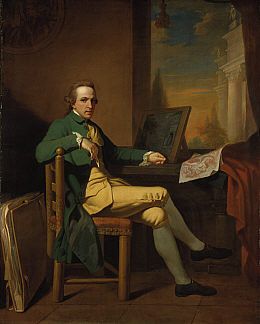
David Allan was a Scottish painter, limner, and illustrator, best known for historical subjects and genre works.
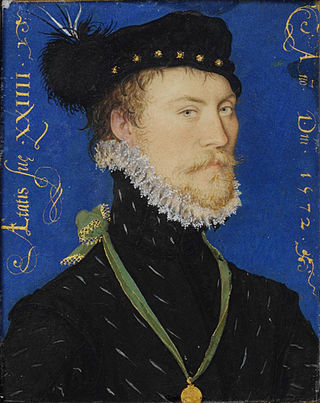
A portrait miniature is a miniature portrait painting, usually executed in gouache, watercolor, or enamel. Portrait miniatures developed out of the techniques of the miniatures in illuminated manuscripts, and were popular among 16th-century elites, mainly in England and France, and spread across the rest of Europe from the middle of the 18th century, remaining highly popular until the development of daguerreotypes and photography in the mid-19th century. They were usually intimate gifts given within the family, or by hopeful males in courtship, but some rulers, such as James I of England, gave large numbers as diplomatic or political gifts. They were especially likely to be painted when a family member was going to be absent for significant periods, whether a husband or son going to war or emigrating, or a daughter getting married.
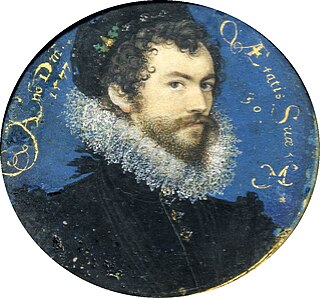
Nicholas Hilliard was an English goldsmith and limner best known for his portrait miniatures of members of the courts of Elizabeth I and James I of England. He mostly painted small oval miniatures, but also some larger cabinet miniatures, up to about 10 inches tall, and at least two famous half-length panel portraits of Elizabeth. He enjoyed continuing success as an artist, and continuing financial troubles, for forty-five years. His paintings still exemplify the visual image of Elizabethan England, very different from that of most of Europe in the late sixteenth century. Technically he was very conservative by European standards, but his paintings are superbly executed and have a freshness and charm that has ensured his continuing reputation as "the central artistic figure of the Elizabethan age, the only English painter whose work reflects, in its delicate microcosm, the world of Shakespeare's earlier plays."
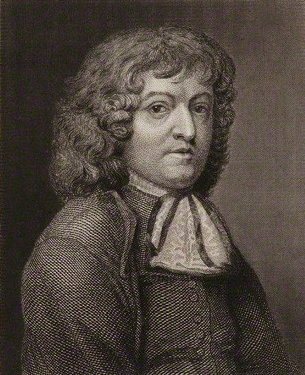
Samuel Cooper, sometimes spelt as Samuel Cowper, was an English miniature painter, and younger brother of Alexander Cooper.

The three Le Nain brothers were painters in 17th-century France: Antoine Le Nain (c.1600–1648), Louis Le Nain (c.1603–1648), and Mathieu Le Nain (1607–1677). They produced genre works, portraits and portrait miniatures.

A court painter was an artist who painted for the members of a royal or princely family, sometimes on a fixed salary and on an exclusive basis where the artist was not supposed to undertake other work. Painters were the most common, but the court artist might also be a court sculptor. In Western Europe, the role began to emerge in the mid-13th century. By the Renaissance, portraits, mainly of the family, made up an increasingly large part of their commissions, and in the Early Modern period one person might be appointed solely to do portraits, and another for other work, such as decorating new buildings.

Cornelius Johnson or Cornelis Janssens van Ceulen was an English painter of portraits of Dutch or Flemish parentage. He was active in England, from at least 1618 to 1643, when he moved to Middelburg in the Netherlands to escape the English Civil War. Between 1646 and 1652 he lived in Amsterdam, before settling in Utrecht, where he died.
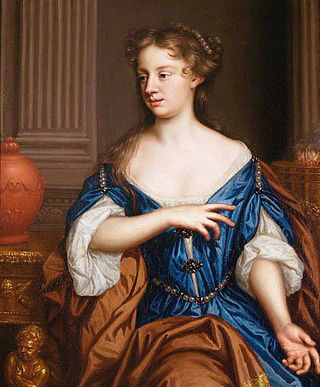
Mary Beale was an English portrait painter. She was part of a small band of female professional artists working in London. Beale became the main financial provider for her family through her professional work – a career she maintained from 1670/71 to the 1690s. Beale was also a writer, whose prose Discourse on Friendship of 1666 presents scholarly, uniquely female take on the subject. Her 1663 manuscript Observations, on the materials and techniques employed "in her painting of Apricots", though not printed, is the earliest known instructional text in English written by a female painter. Praised first as a "virtuous" practitioner in "Oyl Colours" by Sir William Sanderson in his 1658 book Graphice: Or The use of the Pen and Pensil; In the Excellent Art of PAINTING, Beale's work was later commended by court painter Sir Peter Lely and, soon after her death, by the author of "An Essay towards an English-School", his account of the most noteworthy artists of her generation.
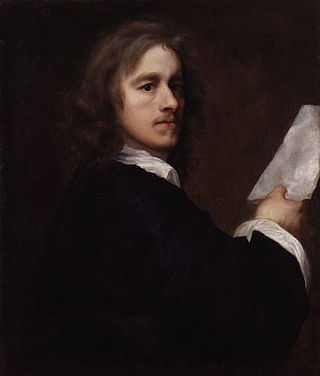
Robert Walker (1599–1658) was an English portrait painter, notable for his portraits of the "Lord Protector" Oliver Cromwell and other distinguished parliamentarians of the period. He was influenced by Van Dyck, and many of his paintings can now be found at the National Portrait Gallery, London.
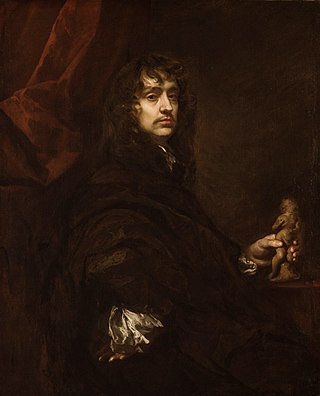
Sir Peter Lely was a painter of Dutch origin whose career was nearly all spent in England, where he became the dominant portrait painter to the court. He became a naturalised British subject and was knighted in 1679.
Sir William Charles Ross was an English portrait and portrait miniature painter of Scottish descent; early in his career, he was known for historical paintings. He became a member of the Royal Academy in 1842.

The artists of the Tudor court are the painters and limners engaged by the monarchs of England's Tudor dynasty and their courtiers between 1485 and 1603, from the reign of Henry VII to the death of Elizabeth I.
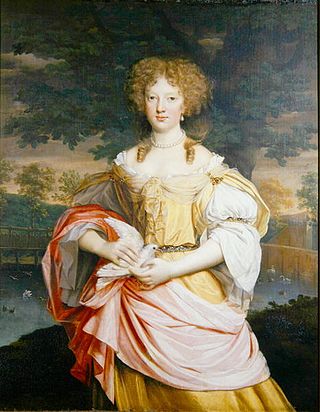
John Michael Wright was an English or Scottish portrait painter in the Baroque style. Wright trained in Edinburgh under the Scots painter George Jamesone, and acquired a considerable reputation as an artist and scholar during a long sojourn in Rome. There he was admitted to the Accademia di San Luca and was associated with some of the leading artists of his generation. He was engaged by Archduke Leopold Wilhelm of Austria, the governor of the Spanish Netherlands, to acquire artworks in Oliver Cromwell's England in 1655. He took up permanent residence in England from 1656 and served as court painter before and after the English Restoration. A convert to Roman Catholicism, he was a favourite of the restored Stuart court, a client of both Charles II and James II, and was a witness to many of the political manoeuvrings of the era. In the final years of the Stuart monarchy he returned to Rome as part of an embassy to Pope Innocent XI.
John Wick was a Dutch baroque painter, best known for his works on military subjects. There are still over 150 of his works known to be in existence.

Gerlach Flicke, Latin name Gerbarus Fleccius, anglicised in the 16th century as "Garlicke", was a German portrait painter who is known for his work in London as an artist of the Tudor court. Flicke was imprisoned in London and he made a portrait miniature whilst there. This painting is the earliest self-portrait in oils made in England.
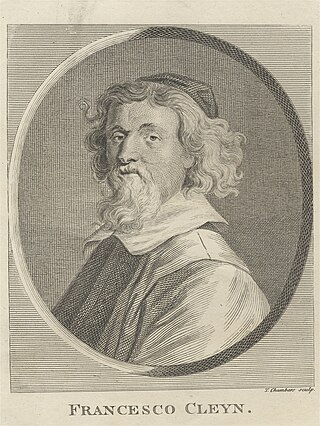
Francis Cleyn was a German-born painter and tapestry designer who lived and worked in England.

An equestrian statue of Charles II trampling Cromwell stands near Newby Hall in North Yorkshire, England. It was previously sited at Gautby Hall in Lincolnshire, and was originally installed at the Stocks Market in the City of London. It is a Grade II listed building.

Christian Richter (1678–1732) was a Swedish miniature-painter and copyist, active mainly in England.





















